Kasper Spiro is the Co-founder and Chief learning strategist of Easygenerator and a recognized thought leader in the world of e-learning. With over 30 years of experience, he is a frequently requested keynote speaker and well-renowned blogger within the e-learning community.
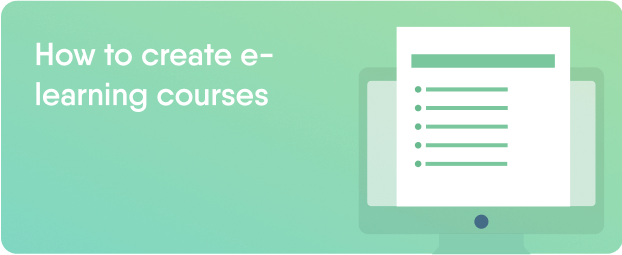
Overview
E-learning. Or online learning as it’s sometimes known. It’s quick, it’s cost-effective, it’s engaging, it will help your organization stay competitive. This type of learning can have a big impact on business. But if you’re not sure how to create an e-learning course, the task can seem daunting. We know, we’ve been there.
When you decide to switch to e-learning there are many ways you can achieve it. You can outsource course creation to a third-party instructional designer or you can buy ready-made content off the shelf. But since you’ve found yourself here, you likely want to create e-learning courses yourself. Or maybe you’re looking to enable your employees to create their own e-learning courses. This last one is known as Employee-generated Learning, and we’ll come to what it is in more detail shortly.
So, if you want to create e-learning courses or simply improve what you’re doing, this guide is for you. Using Easygenerator’s collective decades’ worth of experience we’ll share our tips and best practices on e-learning course development.
Who should create e-learning?
You’re making the move to online learning and creating your own e-learning courses. But should the responsibility of e-learning course development sit within the L&D team, or could you benefit from Employee-generated Learning?
Easy Dictionary
Employee-generated Learning. A learning and development method that shifts responsibility for creating learning content from instructional designers to employees.
It’s often thought that learning and development are best left in the hands of instructional designers. This may have been true in the early days of e-learning when course design was a complex technical task. Now, thanks to modern technologies, it’s easier than ever for your employees to create their own learning content – Employee-generated Learning.
Using modern course authoring software, employees can now easily write and publish training content to be used by their peers. It’s an ideal way to develop e-learning courses because it uses the knowledge that already exists within your organization.
Since your employees have first-hand, on-the-job experience, they will be able to create highly relevant content.
With this model, your L&D team plays a supportive, guiding role to help employees create relevant, engaging, and effective learning content.
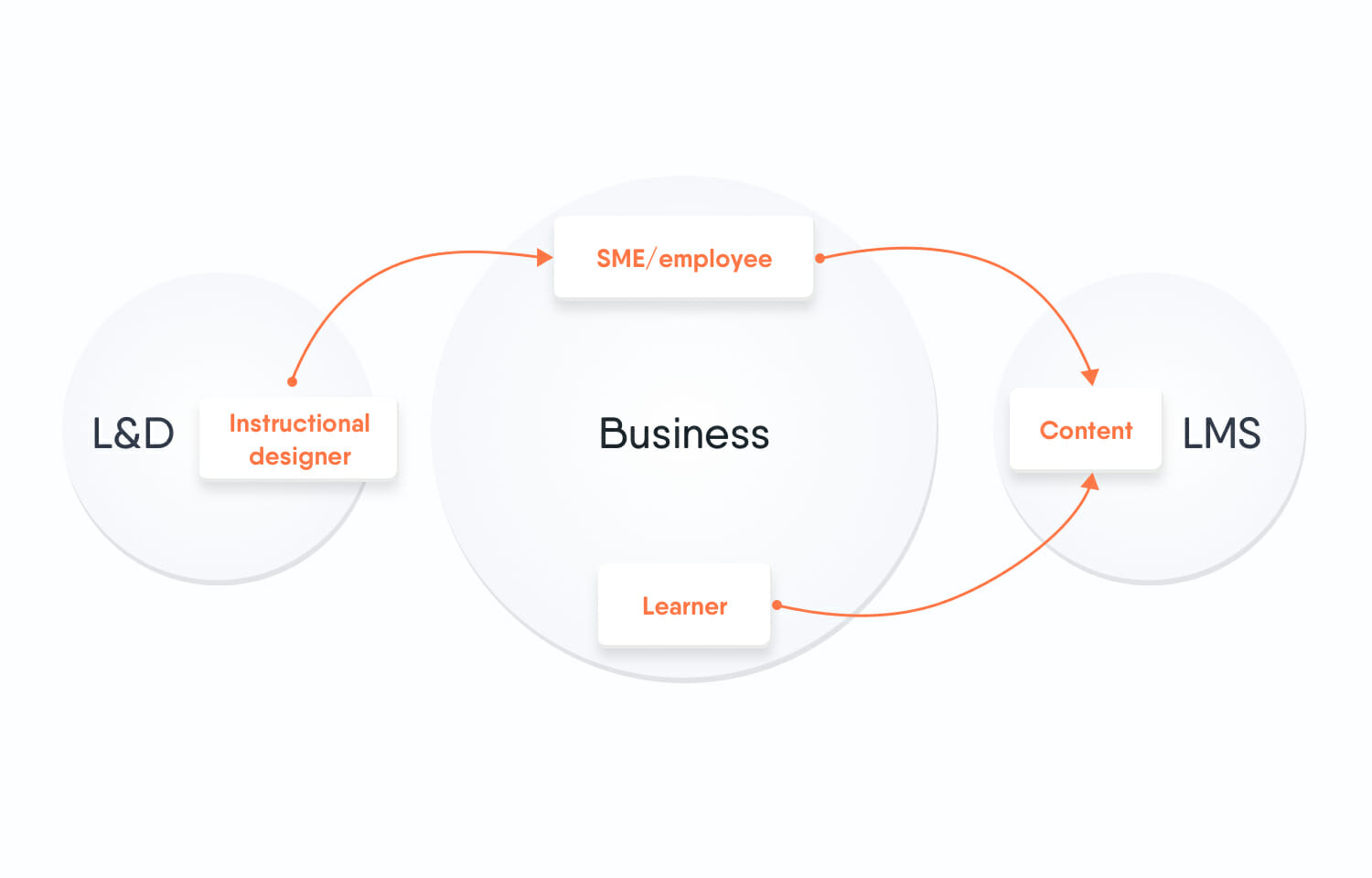
What are the benefits of Employee-generated Learning?
There are many benefits to adopting Employee-generated Learning (let’s call it EGL for short), including:
- Faster and more efficient. Instead of relying on a small number of specialists, you can empower experienced employees throughout the organization to create and share learning content.
- Cost-effective. You don’t have to pay 3rd party trainers, content developers or designers to create courses.
- Agile. It is created by employees who have first-hand knowledge of the business.
- Quickly scalable. It draws from a large pool of content creators: the employees.
- Higher in quality. EGL taps into real-life knowledge and expertise. It educates people on what is truly relevant for them in their jobs. Your L&D team plays the role of assuring the quality of the content and guiding employees to create even more effective content.
- Boosts employee and learner engagement. Content creators can establish themselves as experts among their peers and receive recognition. For learners, the content is more relevant and clearly linked to their everyday work.
- Captures valuable employee knowledge. This means the knowledge remains available to future generations of employees, even after senior employees leave the department or company.
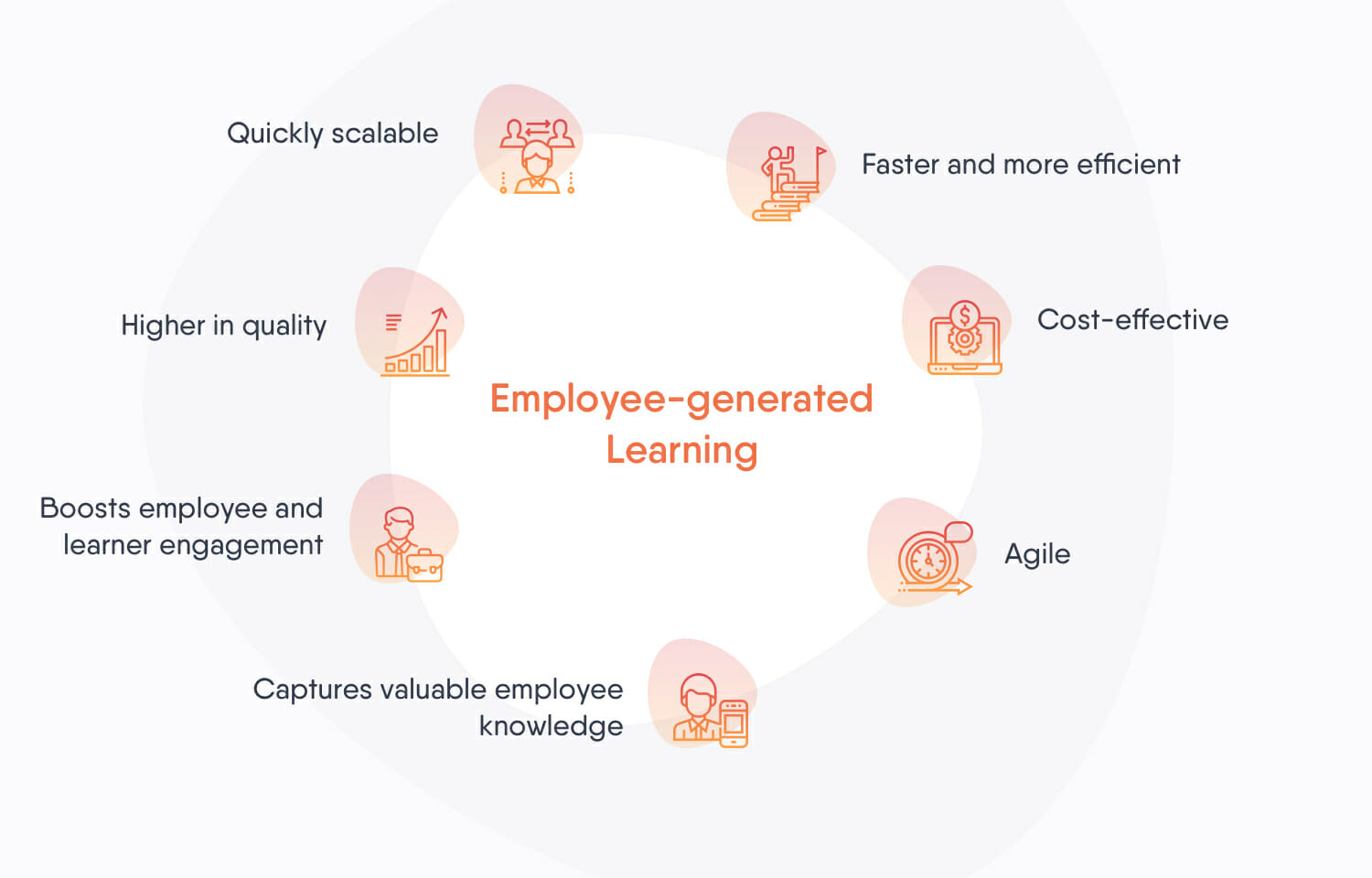
This is only a brief overview of what EGL is and how it can benefit your business. If you’d like to learn more, take a look at our complete guide to Employee-generated Learning.
Before you start creating e-learning
Identifying business needs
Before you create anything, before you even choose the tools you’ll use, you need to identify and be clear about what need you’re trying to fulfill.
The entire purpose of training is to provide your employees with the skills and knowledge they need to perform better at their jobs. When getting started with e-learning, it is a good idea to speak with employees themselves to gain a clearer view of the areas where additional training is needed.
In some cases, the answers may be obvious. For example, if your organization deals with frequent product updates and new product launches, sales and technical support training will generally be an important training area for your business.
What you want to achieve will also help you decide who will create the e-learning. For example, if you need to frequently create and update product training, then an Employee-generated Learning solution may be better for you. Learn more about the benefits of e-learning.
Selecting your e-learning tools
If your company is just getting started with e-learning, you’ll need to decide which software you want to use to write and publish online courses.
When selecting your e-learning tools it’s important to understand who your learners are and what they require. How will they access your course and do you need mobile optimization? What access functionality do you require? Do you need to update content regularly? Etc.
Most organizations combine an LMS with an e-learning authoring tool. This allows you to benefit from the specialist creation and publishing features of both tools. Alternatively, if you’re on a tighter budget and don’t need all the features of an LMS, you can opt for an LMS-Lite.
Check out our article on e-learning authoring tools for Mac.
Easy Dictionary
Learning Management System. Often referred to as an LMS, this software is used to deliver learning content, track and assess results, and generally administer your e-learning. E-learning authoring tool. The name says it all. These are tools that enable you and others within your organization to author your own e-learning content. LMS-Lite. An LMS-Lite is an authoring tool that also includes some of the features of an LMS. Such as publishing and results tracking.
Best practices for creating e-learning courses
Let’s get down to the practical bit — how to create an actual e-learning course. We’ll walk you through each step based on best practices and our experiences in the industry.
Use learning objectives
Before you can even create your e-learning course, it’s essential to start by defining a clear purpose for it. A learning objective is a clear statement of what the learner will take away from the course.
Learning objectives are specific and should be made clear to the learner from the very beginning of the course. This way, there is no misunderstanding about what the point of the course is.
Easygenerator offers a convenient Learning Objective Maker as a standard feature of its course authoring software. The Learning Objective Maker helps course authors define specific learning objectives, so they can create better clearer courses.
One of our blog post tells you even more about the importance of learning objectives and how to use them even more effectively.
Create assessments before writing content
Now that you know the objective of your course, you should create an assessment that will demonstrate your learners have met this objective. The reason we do this before creating the content is you should only be including content that will help them answer these questions and so meet the objectives.
Assessments (such as tests or other kinds of exercises) enable you to quantify how well a learner is internalizing the information from the course. It’s important to remember that results are not just a reflection of the learner’s abilities, but may also reflect on the quality of the course. If the course does a bad job of explaining key information, then it should be no surprise that learners perform poorly on the assessment.
Check out our blog post on how to write content for e-learning and get useful writing tips.
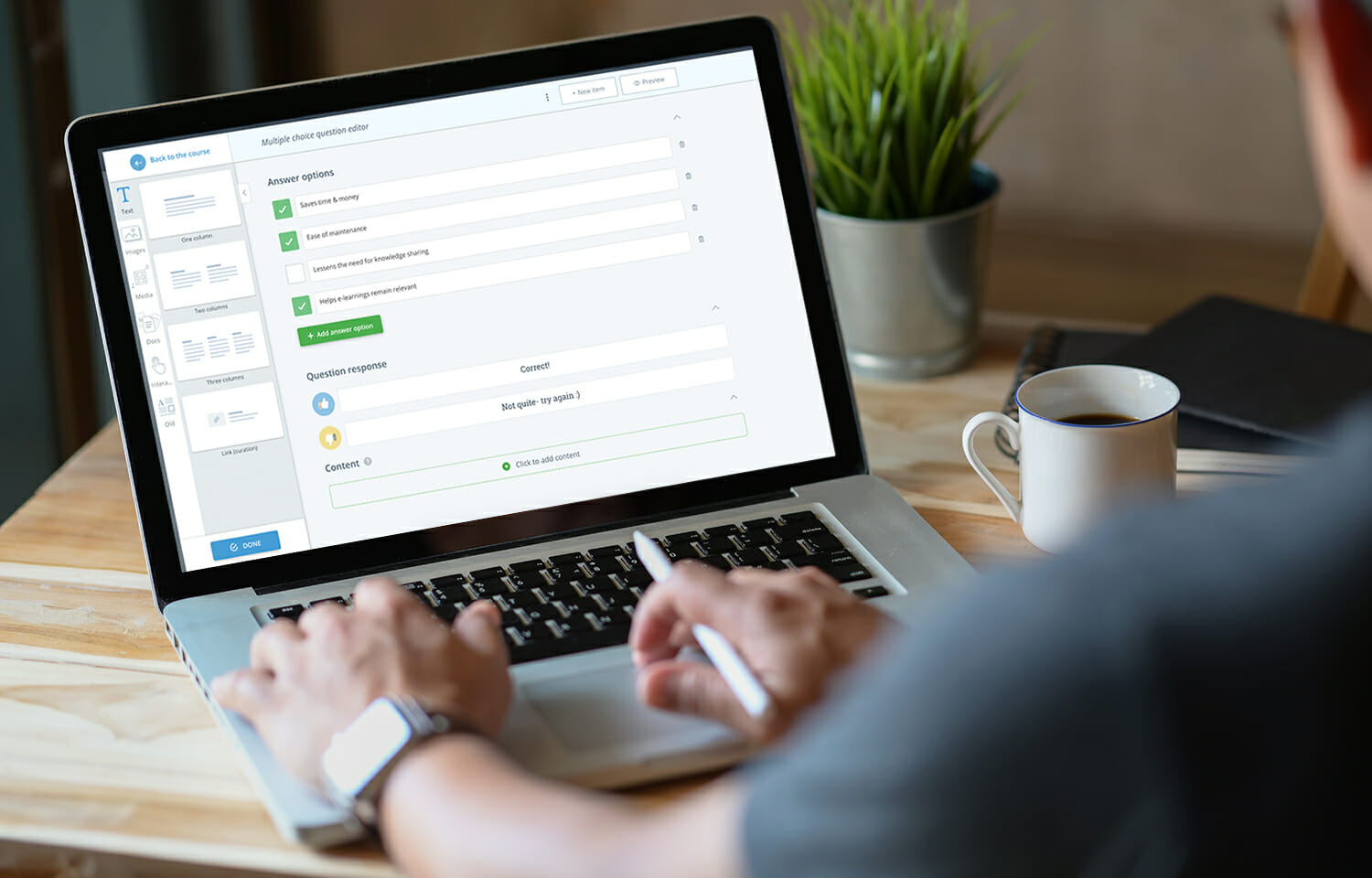
There are many different types of assessments. Be sure you use a variety of assessment types for your course, as variety is proven to boost learner engagement and knowledge acquisition. Also choose assessment types strategically, as some types are better suited than others for specific forms of learning content.
Each of these question types can be very effective when used in the right context. Check out this guide for more information and tips on how to use each question type effectively.
When creating assessments, be sure to include instant feedback that praises learners when they do well, but also encourages them to find the right answers when they are struggling.
Learn how to create responsive e-learning.
Designing your course
Creating an e-learning course is more than simply uploading your PowerPoint presentation (in fact this isn’t best practice). But if you are looking to make use of your existing slides, you can convert your PowerPoint into e-learning using Easygenerator. Read this article to get inspired on how to enhance learner engagement.
But to create an e-learning course, we’ve gathered a few best practices for the design, structure, and text:
Create your e-learning content
- Follow the rules of good writing. Keep sentences (no longer than 20 words) and paragraphs short. Be as specific as possible. Check out our blog post for some great writing tips.
- Keep videos under 6 minutes. Anything over and your learner will lose focus.
- Questions should be quick to answer. It shouldn’t take longer than 30-45 seconds for your learner to answer a question.
Design & structure
- Bite size is the right size. Provide information in small bits (known as “microlearning”) to make it easier to digest. Each course should be under 1,000 words.
- Use a variety of course structures. Variety helps learners remember information more easily. Using different structures for the various parts of your course can help beat the “forgetting curve” (Easygenerator lets you choose from numerous templates and assessment types that make it easy to add variety to your course).
- Two visuals per page. Limit the pictures and visuals you use to only what’s relevant.
Notice that most of them refer to the length of the content. As a rule, the shorter the content, the better. This is because learning in short, easily repetitive intervals is proven to be more effective than studying lengthy texts or watching long presentations. If you struggle to keep your course within these size limitations, consider breaking it into multiple courses instead. Also, making your e-learning content gamified is a good way to engage your learners.
Get feedback from colleagues
We all know the saying “two heads are better than one,” and the same definitely applies when authoring an online course. If you’re creating Employee-generated Learning, ask multiple expert employees to work together on a course or review each other’s work to ensure that no important information is left out.
Easygenerator enables authors to share the link to their course with others (even people who do not have an Easygenerator account), so they can collaborate, and gather useful feedback and insight for improving. Peer review also ensures that the content of the course is accurate and up to date.
Share your course
Once you and your colleagues are happy with the course, it’s time to publish it. How you publish your course will depend on the tools you’re using, but the typical process is to create your course in an authoring tool and download it as a SCORM package. This can then be uploaded to your Learning Management System (LMS).

Your employees can access your course from the LMS, which will track their results and issue certificates (among other things, depending on your LMS).
But even now your course is published, you can’t forget about it. It needs to be maintained and updated, which brings us to our next section.
Maintaining and updating e-learning
Continually gathering feedback to improve your course
Now that you know how to create an e-learning course, it’s crucial to keep it up to date over time.
Once the course is published, it’s crucial to collect learner feedback so that you can tell how effective the content is. This feedback gives the authors valuable insights so they can tweak the course and make sure it is fully catering to the learners’ needs.
One simple yet effective way of measuring the success of a course is a simple survey known as the net promoter score (NPS).
At the end of a course, your learners are asked just one easy question: “On a scale of 1-10, how likely are you to recommend this course to your peers?” Depending on the number they choose, learners will fall into one of these three categories:
- Promoters (score 9-10): learners who found the course very useful and will likely promote it to their peers.
- Passives (score 7-8): those who thought the course was okay, but are generally neutral about it, so will neither encourage nor discourage others to take it.
- Detractors (score 0-6): those who did not think the course was useful and may even discourage others from taking it.
To calculate your course’s NPS, subtract the percentage of detractors from the percentage of promoters.
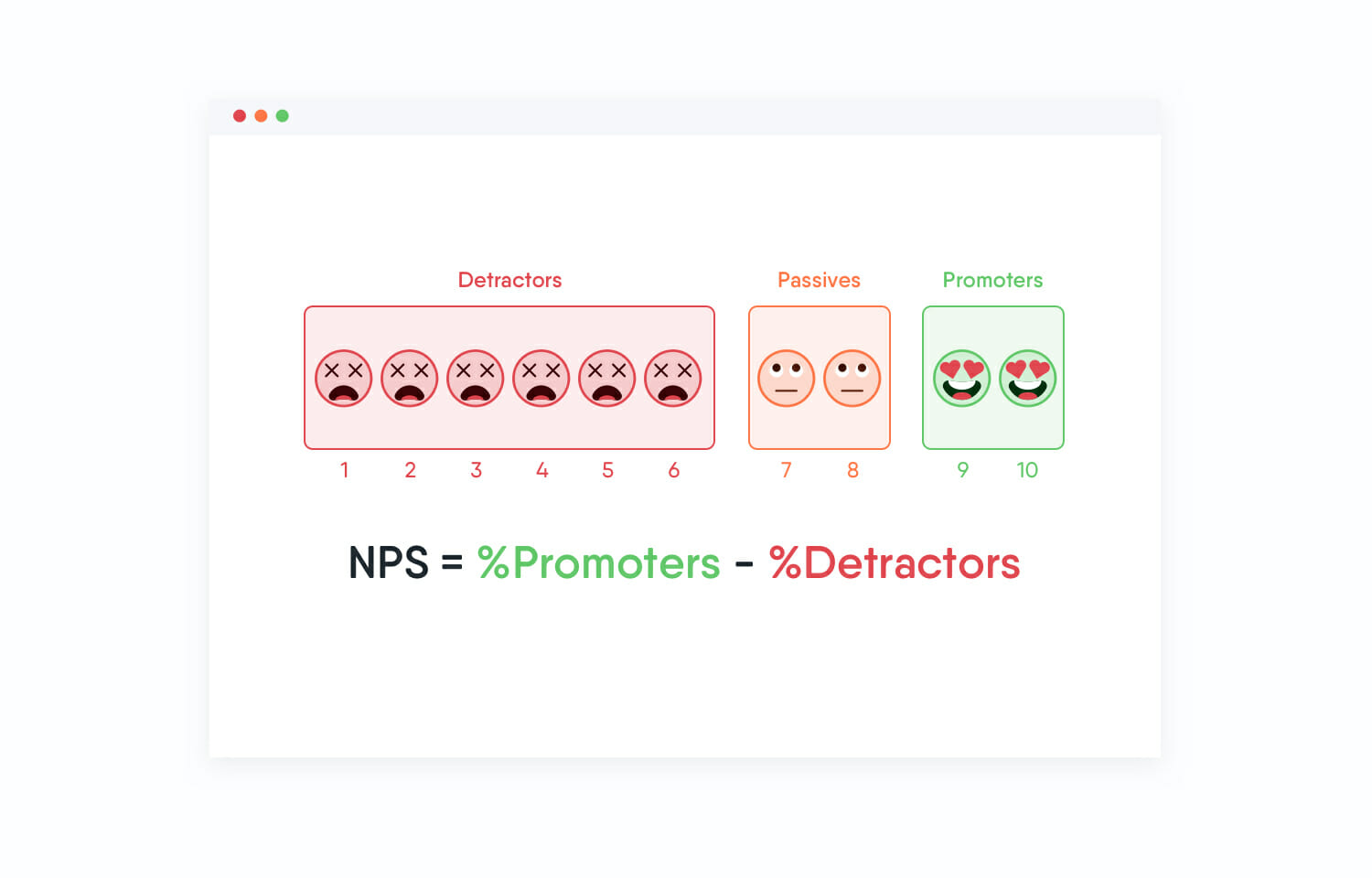
NPS is a useful metric because it gives you a clear insight into how useful your course really is. If a course receives a low NPS, it’s a sign that changes need to be made. After you make changes, you can continue to use NPS to see whether the changes have had the desired effect.
Updating your course
The course creation process doesn’t end once your course is published. In fact, it sort of starts all over again: identifying new learning needs and continually updating the content as topics change over time.
One of the main benefits of e-learning with an Employee-generated Learning model is that it lets you quickly and constantly update course content. This means your training content remains aligned with your company’s real-life business needs.
Be sure that updates are always based on the latest, most relevant facts. Repeat the peer-review process if necessary, before implementing an update. Also, continue to collect feedback, so the content can be adjusted further to ensure good quality.
Creating a course with Easygenerator
Lastly, let’s take a look at how you can use Easygenerator to create a course right away.
Easygenerator uses a simple five-step course-creation process:
Step 1: Create. Use the simple authoring interface to add content and create your course. You can easily add text, images, video and audio files and question types, just by dragging these items from the menu area on the left side of the screen.
While creating the course, you can decide to break content up into multiple sections. The built-in Learning Objective Maker helps you define what the course should be about, so you can always determine whether the content fits or not.
Step 2: Design. Next, you can add customized themes, such as your company’s branding, to the course.
Step 3: Configure. Next, you can adjust various course settings. These include features for tracking learner results, language settings, PDF exporting, etc.
Step 4: Publish. Now, publish the course so you can make it available to learners. You can choose any of these publishing options:
- Easygenerator cloud: This generates a private link that you can share with learners
- Embed the course on your own website
- Publish on your own learning management systems (LMS)
- Publish on a custom domain
Step 5: Results. You can track the learner results using the built-in reporting features. This enables you to automatically issue certifications to learners, but also to monitor learner progress and improve the course’s content when necessary.

Come to check the full comparison of the top 4 e-learning authoring tools!
Time to get started
Now you’re ready to get started on your e-learning journey. Start by putting some of the tips in this article into practice.
As you can see, online training brings many advantages, from cost savings and improved efficiency to quick scalability and better learning outcomes. Especially when you incorporate Employee-generated Learning, your new, online learning strategy will be a powerful investment in your organization’s future.
With online learning and EGL, your organization can easily cater to the learning needs of the modern workforce. At the same time, you create a solid knowledge base that retains valuable knowledge within your organization.
Sign up for a 14-day free trial of Easygenerator and get unlimited access to our features — no credit card required.
